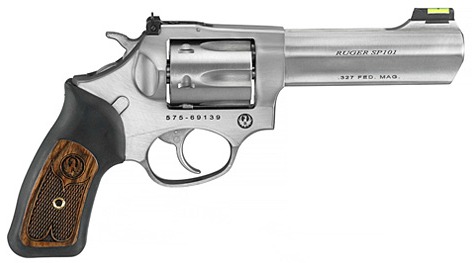
For good deals on 380 auto ammo go to |

For good deals on 380 auto ammo go to |
|
The Right Handgun for YOU May Not be the Most Highly Recommended By Chuck Hawks Let me tell you about a friend who asked me to help her to learn to shoot a handgun. Her primary reason for wanting to learn to shoot was personal protection, first for home defense and eventually for concealed carry. (Like many other beginners, she also discovered shooting is fun!) I always recommend a .22 rimfire to beginning shooters and my friend had never before fired any sort of firearm, so a .22 was the logical place to start. .22 Long Rifle ammunition is cheap, very accurate, mild to shoot and available almost everywhere. In this case, it was also reasonable to look for a .22 similar to handguns also available in centerfire self defense calibers. She tried various types of semi-autos and revolvers until she found one she liked, a Ruger SP101 double action revolver with a 4" barrel in .22 LR caliber. (Like many women with relatively weak hands, she found semi-autos difficult to rack and their magazines a struggle to load.) The Ruger SP101 .22 LR comes with an eight shot cylinder  We went to the range pretty much every week and in time she became an adequate short range shooter, meaning able to keep almost all of her shots in the target's black bullseye out to about 12 yards, or a little beyond. At this point I told her she must continue practicing with her .22, but could consider buying a centerfire revolver specifically for home defense. Of course, she would also need to practice with the new gun. She sensibly chose another 4" Ruger SP101 revolver, nearly identical to her .22, but this time in .327 Magnum caliber with a six shot cylinder. The .327 Mag. in a small frame revolver is too violent for most shooters to handle; it kicks harder than .38 Spec. +P loads. Fortunately, any .327 Mag. revolver can also shoot milder .32 H&R Magnum and very mild .32 Long cartridges. (All of these .32 caliber revolver cartridges actually use .312" diameter bullets.)  The .32 H&H Mag. cartridge proved to be just right for my friend. It is similar in power to the standard pressure .38 Special and kicks less. She did not need to drop down to .32 Long target loads, but could have, if necessary. She kept practicing at the pistol range with both the .22 and .32 SP101s until she became about as good with the .32 as with the .22. By this time she had successfully completed a concealed carry class and gotten her permit, so she began thinking about a lightweight revolver specifically for concealed carry in a handbag. To keep her concealed carry gun as light as possible, but similar to what she was used to, she chose a Ruger LCRx with a 3" barrel in .38 Special +P caliber. This five shot .38 is currently one of the most popular concealed carry revolvers and .38 +P is the most recommended caliber. At this point, things went somewhat awry. Although she had fired my 2" Ruger LCRx .38 before getting hers, she discovered her new 3" .38 Ruger LCRx, even shooting Rem./UMC and Win./USA 130 gr. FMJ practice loads, kicked too hard and caused her to flinch. She had trouble keeping all five shots with the .38 in the black at seven yards, let alone at 12 yards, during our weekly practice sessions. She was, however, still shooting her .22 LR and .32 H&R SP101 revolvers well. The .38's kick remained a problem and I finally suggested she temporarily cease carrying the .38, although she continued to shoot it a little bit during our range sessions. Instead, I suggested she try a 3" LCRx in .22 Magnum caliber for concealed carry. She did and quickly found she could shoot it with confidence. One advantage to the .22 Magnum LCRx is its six shot cylinder.  I guess the moral of the story is everyone must find their own level of recoil tolerance and not exceed it, regardless of how many foot-pounds of energy the chosen cartridge theoretically puts on target. Remember, in real life only vital hits count! At least for now, the .22 WMR turned out to be more appropriate for my friend than the .38 Special in a lightweight concealed carry gun and the .32 H&R in a small frame, but medium weight and length, revolver is just right for home defense. Neither of these are commonly recommended choices, but she can hit what she shoots at, within typical self defense ranges, using these revolvers. For those who are screaming "mouse guns," the Federal .32 H&R Mag. 85 grain JHP self-defense load is faster and hits a little harder than the standard pressure Federal Premium 125 grain Nyclad HP load I carry in my .38 Special LCRx. (ME 235 ft. lbs. compared to 190 ft. lbs. for the .38 Spec.) In time, my friend could eventually move up to shooting .327 Mag. loads (ME 370 ft. lbs.) in her home defense gun, should the need arise. The Federal Premium Low Recoil .327 load (85 grain Hydra-Shok JHP) exceeds the power of the Federal Premium Hydra-Shok .38 Spec. +P, 9mm Luger and some .40 S&W personal defense loads. In closing, let me add that those of us who have done a reasonable amount of varmint, jackrabbit and small predator hunting with a .22 Magnum revolver have seen the damage a 40 grain JHP bullet can do, even at 100 yards, and we have come away with lot of respect for the cartridge. At typical self defense ranges it punches far above its weight class. |
Copyright 2019 by Chuck Hawks. All rights reserved.
|
|